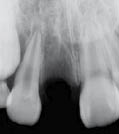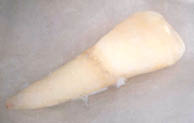(b)  (c)
(c) 
Diagnosis and treatment planning
The diagnosis was avulsion of the 11. The treatment plan had an urgent care component and a follow-up care plan:
1. Initial treatment: Replantation of the avulsed tooth and suturing of the lacerated gingival tissues, followed by stabilizing the replanted tooth with a splint.
2. Follow-up care: Begin root canal treatment within 2 weeks of the replantation and before the splint is removed.
What treatment should be carried out immediately following tooth avulsion?
Current evidence supports that reducing the time between avulsion and replantation is the most important factor in the outcome of tooth avulsion. To that end, when a tooth has been avulsed, every effort should be made to replant the tooth at the site of injury. Even if it has not been adequately replanted, keeping it in its own socket until the situation can be assessed by the dentist, will help to keep the periodontal ligament tissues protected (Table 7.4.1).
Table 7.4.1 Factors affecting prognosis of avulsed teeth
Factors aiding prognosis
|
Factors negatively affecting prognosis
|
However, it is common for the accident victim and/or the persons present at the time of injury not to feel comfortable replacing an avulsed tooth. If that is the case, the patient and the tooth should be brought to a dentist or hospital for replantation as soon as possible.
If the avulsed tooth is not replanted at the time of the accident, how should it be stored?
It is essential to prevent desiccation of the tooth during transport to a treatment facility. When immediate replantation is not carried out, this is best achieved by placing the tooth in the patient’s own mouth and positioning it in the buccal sulcus. Alternatively, the tooth can be stored in milk or saline, the former being a more favourable option. The aim is to maintain the vitality of the periodontal ligament (PDL) cells. Regardless of the storage medium, it is essential to minimize the tooth’s extra-alveolar time (Table 7.4.2).
Table 7.4.2 Appropriate storage media
|
If the tooth has been left dry for a long period of time (more than 1 hour) before it is replanted, what can one expect?
The longer the tooth is exposed to air, dirt and bacteria, the less likely it is that the PDL will be re-established after replantation. If healing does not take place, the necrotic PDL tissue will serve as an inflammatory irritant, stimulating resorption. However, it does not mean that the avulsed teeth, that have been left to dry for more than 60 minutes, cannot and should not be replanted. Even if ankylosis-related resorption is anticipated and, in fact occurs, a replanted tooth can serve the patient well for several years. The older the patient, the longer the tooth can last.
The aim of treatment in these situations is to promote controlled resorption of the root so that it is replaced by alveolar bone. This preserves the dental arch for a period and prevents the development of a bony defect which could be expected if the tooth was extracted or not replanted.
In young patients (below the age of 15 years), if the replanted tooth undergoes ankylosis, the alveolar ridge adjacent to the ankylosed tooth will continue to develop as normal, but the part of the ridge, where the replanted avulsed tooth is located, will not. Then, as the jaw continues to develop, the replanted tooth will start to infraocclude. This will lead to an alveolar ridge defect when the tooth is eventually lost. To prevent this, it is advised that the tooth may be de-coronated when the infraposition of the tooth crown reaches 1 mm. The future treatment procedures (for example implant-retained crown) should be discussed with the patient and their guardians.
Treatment
Stay updated, free dental videos. Join our Telegram channel

VIDEdental - Online dental courses


